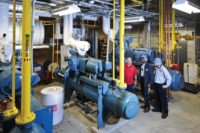Standardization of milk arriving at the dairy allows optimal use of resources and can lead to savings of around US $60,000 per annum.
A recently released milk analyzer from Foss is ideal for standardization of milk arriving at the dairy leading to improved profit and optimal use of resources.ëStandardization' is all about organizing the flow of liquid milk into the dairy process so that it is just right for the task in hand, for example, if you are making cheese, you can achieve the fat to protein ratio upstream of the main process. This avoids any wastage in the system and improves yield.
The recently released MilkoScan FT1 builds on the well proven technology behind the world's most widely used Fourier Transform Infrared (FTIR) milk analyzer, the MilkoScan FT120. A new intuitive software interface makes it easy to perform the fast and accurate milk analysis required for effective milk standardization.
The concept of standardizing milk at intake is increasingly popular as a means to improving economy in dairy production. Producers can make savings by standardizing raw material according to a range of key parameters such as protein, fat and many more, for example, a dairy plant producing 300,000 liters of milk per day can use the accuracy of the MilkoScan to carefully monitor the nature and characteristics of milk in silos with typical savings of around 0.014% fat per processed liter of milk. Over the course of a year, this seemingly small saving mounts up to around US $60,000.
Foss dairy market manager Dorthe Bisgard Oldrup said: "This new solution offers dairy producers a timely opportunity to save money in production by making optimal use of their liquid milk intake." She explains more in a video posted on the Foss website.
Get our new eMagazine delivered to your inbox every month.
Stay in the know on the latest dairy industry trends.
SUBSCRIBE TODAYCopyright ©2024. All Rights Reserved BNP Media.
Design, CMS, Hosting & Web Development :: ePublishing


